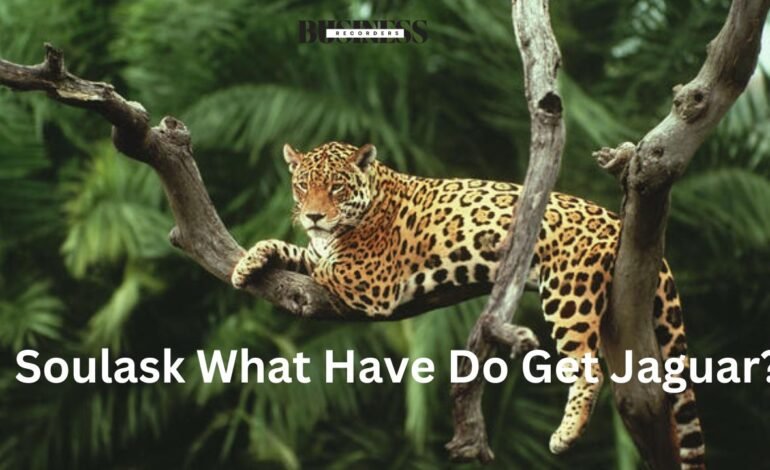
Soulask What Have Do Get Jaguar?
Jaguars are fascinating creatures, known for their strength, beauty, and mystery. This article will address the question, “soulask what have do get jaguar,” exploring various aspects of these amazing animals. By the end of this guide, you will have a thorough understanding of jaguars, their habitats, behavior, and the importance of their conservation. We will also discuss how you can help these big cats and the role they play in our ecosystem. Let’s start learning about jaguars!
What Are Jaguars?
Jaguars are large, powerful cats found primarily in Central and South America. They belong to the Panthera genus, which includes other big cats like lions and tigers. Jaguars are the largest cats in the Americas and the third-largest in the world, after tigers and lions. Their scientific name is Panthera onca, and they are known for their distinctive yellow coat with black rosettes, which helps them blend into their rainforest habitats.
The jaguar’s body is muscular and stocky, designed for strength rather than speed. An adult male jaguar can weigh between 100 to 250 pounds, with females being slightly smaller. They have a powerful bite, which is among the strongest of all big cats. This unique feature allows them to crush the skulls of their prey and even penetrate the shells of turtles.
Jaguars are solitary animals, preferring to roam alone in their territory, which can cover up to 50 square miles. They are mainly nocturnal hunters, active during the night. Their keen eyesight and excellent hearing help them locate prey in the dense forests where they live. Understanding the question, “soulask what have do get jaguar,” gives insight into the incredible adaptations these cats have developed over time.
Where Do Jaguars Live?
Jaguars primarily inhabit rainforests, swamps, and grasslands. They are most commonly found in the Amazon Basin, which spans several countries, including Brazil, Peru, and Colombia. These regions provide the dense cover they need for hunting and protection. Jaguars are also found in other areas like the Pantanal in Brazil, a vast wetland that offers abundant food sources.
While they thrive in lush, tropical environments, jaguars can adapt to different habitats. They can be found at elevations of up to 10,000 feet in the Andes Mountains, showcasing their versatility. Jaguars are excellent swimmers, often using rivers and lakes to travel. This ability allows them to expand their territory and find food more easily.
Sadly, jaguar habitats are under threat due to deforestation, agriculture, and urban expansion. As forests are cleared for farming and development, jaguars lose their homes and hunting grounds. This habitat destruction is a major factor contributing to their declining populations. Protecting these areas is essential for the survival of this magnificent species. By understanding “soulask what have do get jaguar,” we can appreciate the urgent need for habitat preservation.
What Do Jaguars Eat?
Jaguars are carnivorous animals that have a diverse diet. They are known as opportunistic hunters, which means they will eat whatever prey is available in their territory. Their primary food sources include deer, peccaries, capybaras, and various birds. Jaguars are also unique in that they can hunt reptiles, such as caimans and turtles, which many other big cats avoid.
One fascinating aspect of a jaguar’s hunting technique is its method of killing prey. Jaguars have extremely powerful jaws and can bite through the shells of turtles and the skulls of other animals. This ability allows them to hunt a variety of prey effectively. Their strong muscles and excellent swimming skills make them skilled hunters in both land and water environments.
Jaguars often stalk their prey quietly and then launch a quick attack. They can leap up to 10 feet in the air and can pounce from trees or bushes. Their spots and rosettes help them remain camouflaged in the dense underbrush, making it easier to sneak up on unsuspecting animals. After making a kill, jaguars often drag their prey to a secluded spot to eat in peace, protecting their meal from scavengers.
| Pros and Cons of Jaguar Hunting | Benefits | Disadvantages |
| Important for ecosystem balance | Helps control prey populations | Can lead to human-wildlife conflict |
| Source of food for many species | Contributes to biodiversity | Prey scarcity can threaten jaguars |
| Cultural significance in local lore | Promotes tourism and conservation | Risk of extinction due to habitat loss |
Why Are Jaguars Important?
Jaguars play a vital role in maintaining the health of their ecosystems. As apex predators, they help control the populations of other animals, which keeps the balance in nature. When jaguar populations decline, it can lead to overpopulation of prey species, which can harm vegetation and disrupt the entire ecosystem.
The presence of jaguars in an environment helps maintain biodiversity. By controlling herbivore populations, they prevent overgrazing, allowing plants to thrive. This, in turn, supports other wildlife species that depend on those plants for food and shelter. Jaguars are sometimes referred to as “keystone species” because their impact on the ecosystem is disproportionately large compared to their abundance.
In addition to their ecological role, jaguars are also culturally significant to many indigenous peoples. They symbolize strength and power in various cultures, appearing in myths and folklore. Protecting jaguars helps preserve these cultural heritages and encourages sustainable practices among local communities. In many regions, jaguars are considered sacred animals, and their protection is integral to the identity of local tribes. This cultural aspect ties back to the question, “soulask what have do get jaguar,” emphasizing the value of these magnificent creatures.
What Are the Threats to Jaguars?
Jaguars face several threats that endanger their survival. Habitat loss is one of the most significant issues, primarily due to deforestation for agriculture and urban development. As forests are cleared, jaguars lose their homes and hunting grounds, making it harder for them to survive. In some areas, roads and highways further fragment their habitats, isolating populations and making it challenging for them to find mates and food.
Poaching is another serious threat. Jaguars are hunted for their beautiful fur and for their body parts, which are used in traditional medicine. The illegal wildlife trade puts immense pressure on jaguar populations, making it difficult for them to recover. In addition, human-wildlife conflict poses risks, as farmers may kill jaguars to protect their livestock. This conflict often arises from a lack of understanding about jaguar behavior and their importance in the ecosystem.
Another threat to jaguars is climate change. Changes in weather patterns can affect their habitats, leading to food shortages and altering their natural behaviors. For example, increased flooding or droughts can impact prey availability and habitat conditions. Addressing these threats is crucial for ensuring the future of jaguars and their habitats. Understanding the phrase “soulask what have do get jaguar” highlights the urgent need to tackle these challenges through collective action.
How Can We Help Jaguars?
There are many ways individuals can help protect jaguars and their habitats. Supporting conservation organizations is one effective method. Many groups work to protect jaguar habitats and educate local communities about the importance of these animals. Donations can help fund these initiatives and contribute to research efforts.
Additionally, promoting sustainable practices in agriculture and forestry can have a positive impact on jaguar conservation. By choosing products that are sustainably sourced, consumers can help reduce habitat destruction. Awareness campaigns can educate people about the importance of protecting jaguars and the actions they can take to help. Simple actions like using less paper or supporting companies that practice eco-friendly methods can contribute to preserving jaguar habitats.
Another effective way to help is through responsible tourism. Ecotourism promotes visits to natural areas while helping to protect the environment and support local economies. Travelers can learn about jaguars and their habitats, contributing to awareness and conservation funding. Participating in conservation programs or volunteering with wildlife organizations can also provide hands-on opportunities to help protect these magnificent animals.
By actively engaging in conversations about “soulask what have do get jaguar,” individuals can inspire others to take action for jaguar conservation. Each person’s efforts can contribute to the larger goal of protecting these incredible animals and their habitats.
What Is the Future of Jaguars?
The future of jaguars largely depends on conservation efforts and the commitment of individuals and communities to protect these magnificent animals. While they are currently listed as near threatened, ongoing habitat loss and poaching could push them closer to extinction.
Fortunately, there are initiatives in place to protect jaguars and their habitats. Many countries have established protected areas and wildlife corridors to allow jaguars to roam safely. International cooperation is also crucial for protecting these animals, as they do not recognize human-made borders. For instance, organizations like the World Wildlife Fund (WWF) and Panthera work across borders to conserve jaguar populations.
Community involvement is essential for successful conservation. Engaging local populations in conservation efforts can lead to better outcomes. When communities understand the value of jaguars and are involved in protecting them, they are more likely to support conservation initiatives. Education plays a significant role in building this understanding and fostering a sense of responsibility for the environment.
With continued efforts and support, there is hope for a brighter future for jaguars. Ongoing research can help identify critical habitats and monitor populations, guiding effective conservation strategies. Collaboration among governments, NGOs, and local communities is essential for ensuring that jaguars have the space and protection they need to thrive. The awareness of “soulask what have do get jaguar” can serve as a rallying cry for individuals to contribute to these efforts.
Conclusion
In summary, jaguars are incredible creatures that play a crucial role in their ecosystems. Understanding the question “soulask what have do get jaguar” is a step toward appreciating their importance and the challenges they face. By learning about their habits, habitats, and the threats they encounter, we can work together to protect them.
Taking action for jaguar conservation benefits not only these big cats but also the entire ecosystem they inhabit. Each individual can contribute to preserving this magnificent species through education, awareness, and sustainable practices. By working together, we can ensure that future generations will have the opportunity to admire and respect the beauty and strength of jaguars. Let us unite in the quest to protect these majestic animals and keep their habitats safe.













